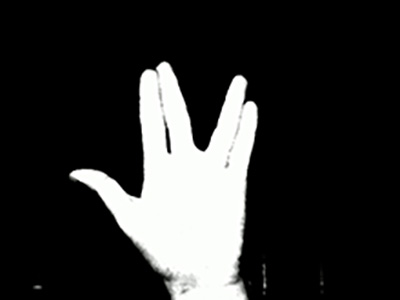got the best news ever the other day: new Star Trek in 2017! Yeah so, I’m a Trekker, and I have been for most of my life now. I see about half of you judging me over there…go ahead, it’s fine. Star Trek has undergone a resurgence over the past few years due to those movies that came out (although vocal fans of Red Reznikov from Orange is the New Black a.k.a. Kate Mulgrew a.k.a. Captain Janeway may also account for some of its newfound popularity). I can tell that this recent renaissance annoys the older fans sometimes, but I’m of the opinion that this can only be a good thing.
It’s well-known that the technology featured in Star Trek has been the driving force behind a lot of important scientific and technological breakthroughs this past century (iPads! The quest for a warp drive!). But Star Trek has also been a source of personal inspiration for many over the years due in large part to its groundbreaking premise and casting. Star Trek was created by Gene Roddenberry and premiered in 1966. It portrayed humans 300 years in the future in the 2260s as a spacefaring people, who had settled their differences on Earth and lived side by side with alien species. At the time, this was a revolutionary idea for a television show, as the United States was embroiled in both the civil rights movement and the cold war. The cast of the show was also radical, featuring a Japanese helmsman, Lieutenant Hikaru Sulu (played by George Takei, Ohhh Myyyyyy), a female African American communications officer, Lieutenant Nyota Uhura (played by Nichelle Nichols), and a Russian crewmember, Ensign Pavel Chekov (played by Walter Koenig) who was added in the second season. It seems trite to refer to these characters by their ethnicity and gender in the present day, but at the time, the casting of these particular characters signaled that there was at least some hope that the future would be a better place.
The casting of Nichelle Nichols as Lt. Uhura was particularly meaningful for many African Americans, especially African American girls and women. During the run of the series, Nichols contemplated leaving the show to pursue other career opportunities, but Dr. Martin Luther King, Jr. convinced her to stay on, since her character was the first to show an African American, and particularly a woman, as an equal. And what do you know, he was totally right. A number of people cite Nichols’ portrayal of Lt. Uhura as a source of inspiration. One notable example is Dr. Mae Jemison, who grew up watching Star Trek and was inspired to join NASA based on the character of Lt. Uhura. In an interview in The Stanford Today, she discussed how the character had opened her eyes to the possibility of space travel, and also mentioned that she called Nichols prior to her mission on the space shuttle Endeavour to thank her for her inspiring work. Even though a lot of people like to scoff at Star Trek’s inherent nerdiness, it has been a cultural phenomenon that has had profound influence on many people.
Since I am both a Trekker and a scientist, you are probably thinking that my career in science was somehow influenced by Star Trek. And yes, you are absolutely right. I never really got into watching The Original Series, but I watched Star Trek: Voyager when I was growing up. Yes, I know, I just admitted that my favorite Star Trek is the one considered by many to be a lesser series, falling far behind The Next Generation and even Deep Space Nine in plot quality and creativity. But one of the great things about being a child and watching television is that all storylines seem new and flashy graphics are immensely impressive.
Much like The Original Series, Star Trek: Voyager had a widely diverse cast, including the first female captain (Red!) to lead a Star Trek franchise (but not the first shown on screen) and a female Hispanic chief engineer, Lt. B’Elanna Torres, played by Roxann Dawson. This show gave my younger self, a Hispanic girl, the opportunity to see women, and particularly a Hispanic woman, in positions of power. Every week they got to be scientists (the captain’s primary training was actually as a science officer) and kick butt (they must have run out of bubblegum). I was so inspired by these characters that I switched my primary career aspiration from country singer to biologist when I was nine (mission accomplished!).
I’m really excited to see what the new Star Trek series has to offer, and I hope the writers actually give it the ability to inspire a new generation of kids to pursue science. In the meantime, I’m taking a note from Star Trek and trying to be as visible as possible as a woman of color in science. Who knows, maybe one day I’ll inspire someone, too.
Further reading:


